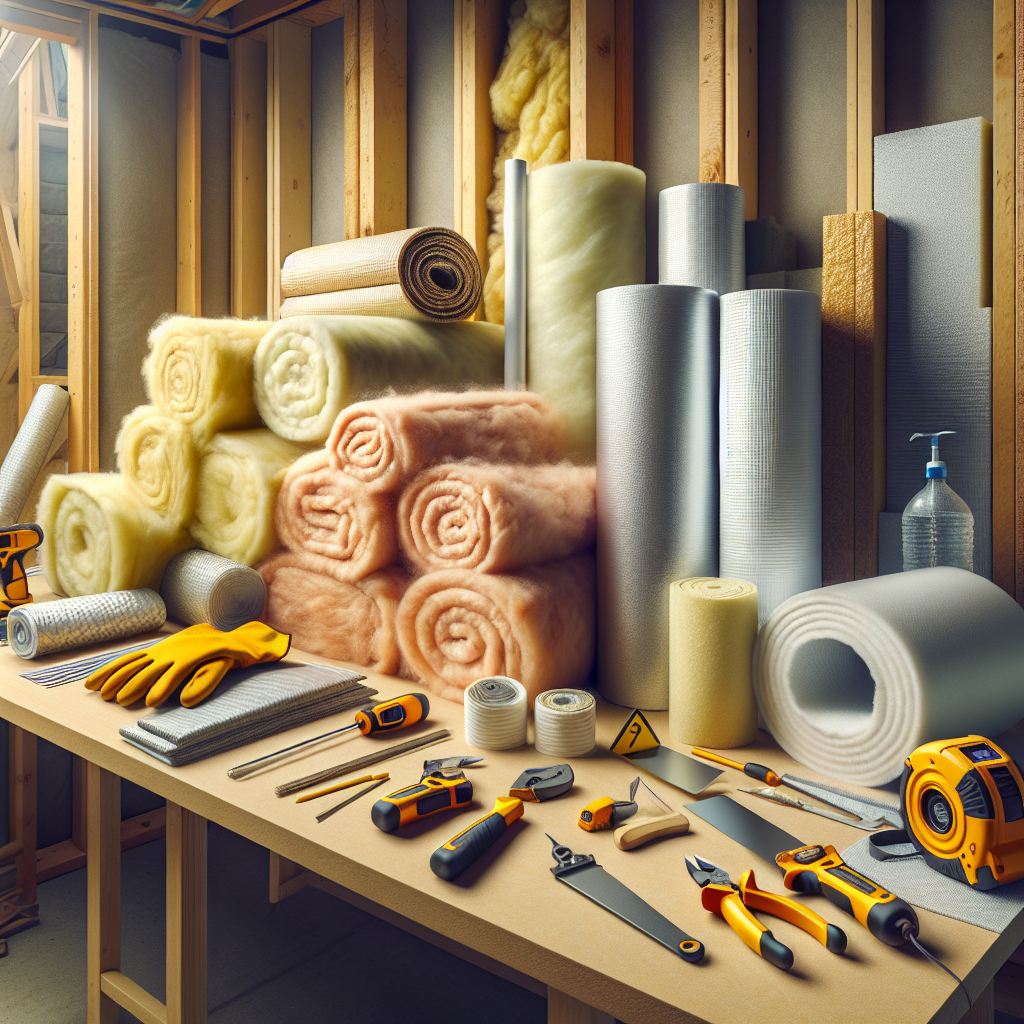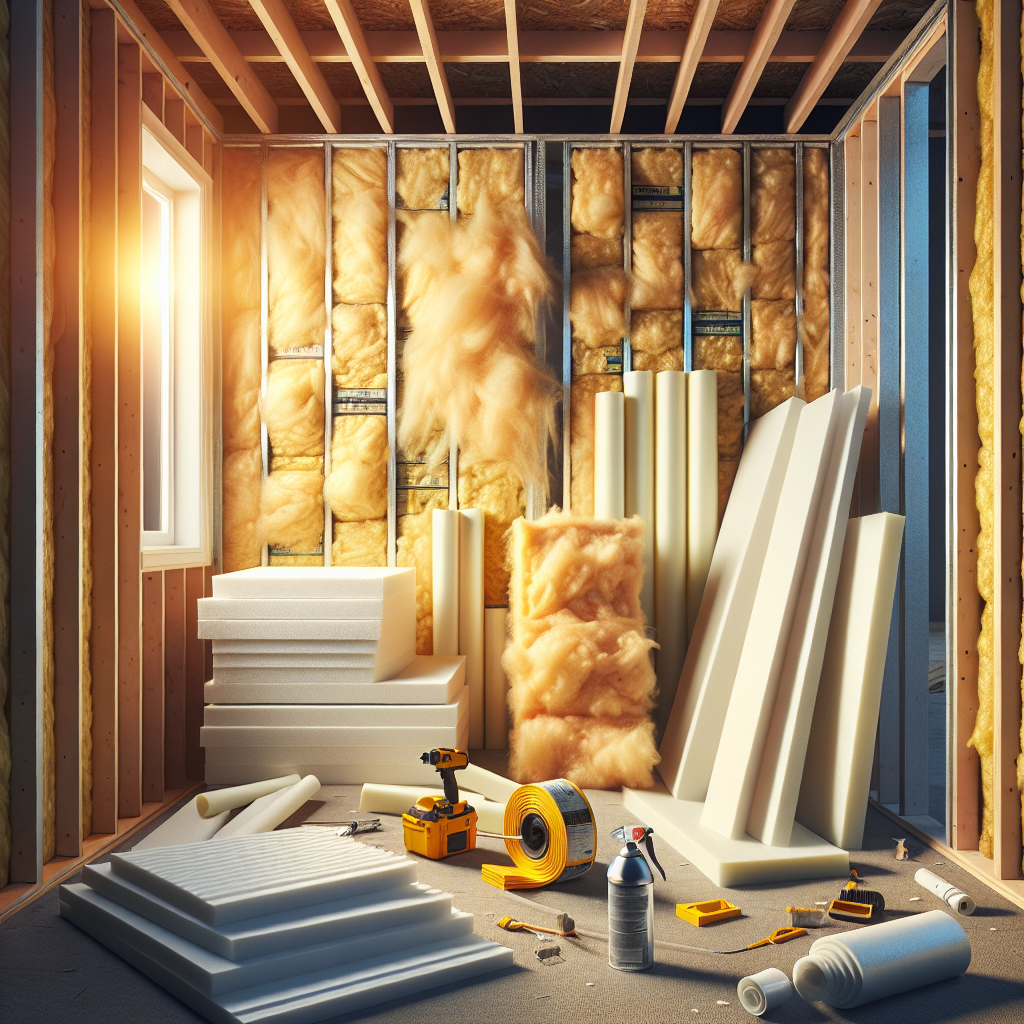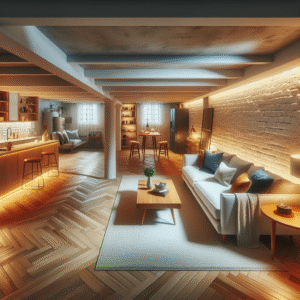Understanding R-Values: Key to Selecting Home Insulation
Welcome to our latest feature at BuildNet, where we dive deep into the essentials of home maintenance and improvement. Today, we’re tackling an often overlooked but crucial aspect of home comfort and energy efficiency—insulation. Whether you’re building a new home or upgrading your current abode, understanding the R-value of insulation can make all the difference in your energy bills and overall comfort.
Types of Insulation: Benefits and Ideal Use Cases
Insulation comes in various forms, each with its unique properties and optimal use scenarios. In this section, we’ll explore the different types of insulation materials available, such as fiberglass, spray foam, and rigid foam boards, and discuss which might be the best fit for your home. By comparing the benefits and ideal use cases, you’ll be equipped to make an informed decision that ensures maximum efficiency and comfort.
Installation Insights: Hiring Professionals vs. DIY Insulation Techniques
Installing insulation can be a daunting task, especially if you’re considering a DIY approach. We’ll provide you with practical tips and insights on when it’s best to hire a professional versus tackling the job yourself. From understanding the complexities of installation to ensuring safety and effectiveness, we’ll help you navigate these choices, ensuring your insulation project is a success.
Join us as we break down these topics, providing you with knowledgeable advice and practical tips that will help you enhance your living space while keeping those energy costs down. Perfect for homeowners looking to improve their home’s energy efficiency and comfort, this guide will support your journey every step of the way!

If you’re ready to take your home improvement or construction project to the next level, we can help! Find trusted contractors on BuildNet, whether you’re looking for renovations, new builds, electrical work, plumbing, or anything in between. Our directory connects you with qualified professionals who can make your vision a reality.
Understanding R-Values: Key to Selecting Home Insulation
Welcome! If you’re diving into the world of home insulation, one term you’re going to see over and over is R-value. But what exactly is an R-value, and why is it so crucial when choosing the right insulation for your home? Let’s unravel this essential concept in a way that’s easy to grasp, even if you’re not a professional builder.
What is an R-Value?
Simply put, an R-value measures the thermal resistance of an insulation material. It’s a gauge of how well a particular insulation can resist the flow of heat. The higher the R-value, the greater the insulation’s effectiveness. This means a material with a high R-value will do a better job keeping warm air inside during the winter and hot air outside during the summer.
Think of it like the insulation’s ability to put up a “stop sign” against unwanted temperature changes. Whether you’re heating or cooling your home, a higher R-value helps maintain your desired indoor climate more efficiently, contributing to lower energy bills and a more comfortable living environment.
How Are R-Values Measured?
R-values are determined through standardized testing to ensure they accurately reflect the insulation’s capabilities. These tests measure how much heat is lost or gained through a material. It’s important to note that R-values are cumulative. This means that if you layer two materials each with an R-value of 5, the total R-value of the combined materials would be 10.
Factors Influencing R-Values
Several factors can affect the R-value of insulation, including:
- Material: Different insulating materials have differing R-values. For instance, fiberglass, foam, and cellulose each have their own typical R-value ranges.
- Thickness: Generally, thicker materials provide better insulation and hence have higher R-values.
- Density: Denser insulation can sometimes offer better resistance to heat flow.
- Age: Over time, some insulation materials can settle or degrade, which may reduce their R-value.
- Moisture Accumulation: Wet insulation has a significantly lower R-value than dry insulation.
Choosing the Right R-Value for Your Home
Determining the optimal R-value for your home insulation depends largely on your geographic location and the specific part of your home you’re insulating. For example, what works in the chilly climates of the northern United States might be overkill for the milder southern regions.
Geographic Considerations
The U.S. Department of Energy provides region-specific recommendations for R-values based on the typical climate conditions. In colder areas, higher R-values are recommended, especially for attics and roofs where the majority of heat loss occurs.
Area of the Home
The required R-value also varies depending on where in your home the insulation is being installed:
- Attics: As heat rises, attics often need higher R-values. R-30 to R-60 is typically recommended depending on climate.
- Walls: Walls usually require a lower R-value than attics. Depending on the exterior wall construction, R-13 to R-21 is often sufficient.
- Floors: Insulation for floors can vary widely, but R-25 to R-30 can be appropriate in colder climates.
Why the Right R-Value Matters
Selecting the correct R-value is more than just a technical necessity—it’s about comfort, cost-effectiveness, and energy efficiency. Here’s why getting it right matters:
- Enhanced Comfort: Proper insulation helps maintain a consistent temperature throughout your home, making it more comfortable year-round.
- Energy Savings: High R-value insulation can significantly reduce heating and cooling costs by minimizing energy waste.
- Environmental Impact: By using less energy to heat and cool your home, you’re also reducing your carbon footprint.
- Moisture Control: Good insulation also helps prevent moisture problems, which can lead to mold growth and structural damage.
Embarking on a home insulation project can seem daunting, especially with terms like R-values flying around. However, understanding this crucial measure is the first step towards making informed decisions about how to best insulate your home. Remember, every bit of effort put into selecting the right insulation pays off in improved home comfort and reduced energy bills. So, take the time to examine your needs, consult with professionals if necessary, and choose the insulation that best fits your home’s requirements.

Types of Insulation: Benefits and Ideal Use Cases
Hello there, savvy homeowner! Are you getting ready to battle the heat of summer or the chill of winter by beefing up your home’s insulation, but not quite sure where to start? Well, you’ve come to the right place! Let’s dive into the exciting world of insulation where we decode different types, their benefits, and where they best fit in your home. After all, choosing the right insulation can be a game-changer for your comfort and energy bills!
1. Batt and Roll Insulation (Fiberglass and Mineral Wool)
Let’s kick things off with one of the most common types of insulation — batt and roll. Typically made from fiberglass or mineral wool, these materials come in convenient pre-cut panels or rolls that fit snugly between wall studs, ceiling joists, and floor joists.
- Benefits: Batt insulation is cost-effective and relatively easy to install, making it a great DIY project. It’s also effective at slowing down the spread of fire and reducing noise.
- Ideal Use Cases: It’s perfect for new construction projects and areas with standard spacing between joists and studs, particularly in unfinished walls, floors, and ceilings.
2. Spray Foam Insulation
Moving on to the high-tech option in the insulation family — spray foam. This type comes in two forms: closed-cell and open-cell, both of which are applied wet and expand into thick foam that hardens upon drying.
- Benefits: Spray foam insulation offers excellent thermal and air barrier properties. Closed-cell foam, in particular, adds structural strength to your walls and can help block moisture.
- Ideal Use Cases: This type is a superstar in sealing cracks and gaps, making it ideal for attic floors and finished walls. It’s also a go-to choice for areas prone to moisture issues or where higher R-values are required.
3. Rigid Foam Board Insulation
Next up is rigid foam board or rigid panels, which provide insulation through dense sheets of foam plastics such as polystyrene, polyisocyanurate (polyiso), and polyurethane.
- Benefits: With a higher insulating value per inch than fiberglass or mineral wool, rigid foam boards are great for reducing heat conduction through structural elements like wood and steel studs.
- Ideal Use Cases: Think basements and crawl spaces! They’re also perfect for insulating exterior walls and for re-siding projects.
4. Loose-fill and Blown-in Insulation
Imagine a massive pillow fight, but instead of feathers, you have fluffy materials like cellulose, fiberglass, or mineral wool. That’s loose-fill and blown-in insulation for you, which is installed using a special machine that blows the insulative materials into place.
- Benefits: This type is fantastic at filling in hard-to-reach spaces, irregular areas, and around obstructions. It’s also good for adding insulation to existing finished areas.
- Ideal Use Cases: Top choice for attics, or adding extra insulation over existing finished areas without much disturbance to the existing structure.
5. Reflective or Radiant Barrier Insulation
And now for something a little different — radiant barrier insulation. Unlike traditional materials that slow down heat flow, reflective insulation reflects heat away from your living space, keeping it much cooler.
- Benefits: Super effective at combating heat gain in warm climates and known to reduce cooling costs drastically.
- Ideal Use Cases: Best used in attics of homes located in warm regions to reflect heat away and keep the cool in.
6. Structural Insulated Panels (SIPs)
Last but certainly not least, we have SIPs — panels made from a layer of foam insulation sandwiched between pieces of plywood, oriented strand board (OSB), or fiber-cement. SIPs provide an airtight and strong structural option for modern energy-efficient buildings.
- Benefits: Provides superior and uniform insulation compared to more traditional construction methods, as well as quicker installation times.
- Ideal Use Cases: Excellent for new constructions such as homes, sunrooms, or additions where energy efficiency is a high priority.
Choosing the right type of insulation for your home can feel like a hefty task, but armed with this knowledge, you’re well on your way to making an informed decision that will keep your home comfortable and your energy bills in check. Remember, when it comes to insulation, it’s not just about stuffing your walls with any material you can find. It’s about carefully selecting the right type that meets the specific needs of your space and climate. Happy insulating!
Installation Insights: Hiring Professionals vs. DIY Insulation Techniques
When it comes to installing insulation in your home, you’re faced with a pivotal decision: Should you hire a professional, or can you handle it yourself (DIY)? Let’s dive deep into both paths to help you make an informed choice that suits your needs, budget, and comfort level.
Hiring Professional Insulators
Why Consider Hiring Professionals?
Hiring a professional insulation team comes with a plethora of benefits that can make it an attractive option for many homeowners. Here are a few points to consider:
- Expertise: Professional insulators are skilled and knowledgeable, often backed by certifications and training specific to the industry.
- Efficiency: With experience comes speed. Professionals can often complete the job more quickly and with fewer hiccups than the average DIY enthusiast.
- Quality: When you hire professionals, you usually get a guarantee on the workmanship, which can provide peace of mind and potentially cover you if something goes awry.
- Advice: Insulation needs vary by climate and house design. Professionals can offer tailored advice on the best types of insulation for your specific circumstances.
Considerations When Hiring Professionals:
Hiring professionals does sound pretty great, but there are a couple of things to keep in mind:
- Cost: Professional services often come with a higher price tag. However, the investment might be worth it for the quality and hassle-free experience.
- Finding the Right Contractor: It’s essential to choose a reputable insulation contractor. Checking online reviews, seeking recommendations from friends, or using a trusted directory like BuildNet can help ensure you find a top-notch professional.
DIY Insulation Techniques
Going the DIY Route:
If you’re handy and looking to save some cash, DIY insulation might be up your alley. Here’s what you need to know:
- Cost-Effective: The most apparent benefit of DIY insulation is cost savings. You’re basically paying for materials only.
- Personal Satisfaction: There’s a unique sense of accomplishment that comes from doing the work yourself and seeing the results of your labor.
DIY Challenges:
However, DIY isn’t without its challenges:
- Learning Curve: If you’re new to insulation, you’ll need to spend time learning about different materials and techniques. This can involve a lot of trial and error, which can be frustrating.
- Risks: Incorrect installation can lead to issues like mold growth or inefficiency in heating and cooling, which might negate the savings on your energy bills.
- Time Investment: Insulating a home is time-consuming, especially for beginners. You’ll need to be prepared to dedicate weekends or full days to the project.
Choosing Between DIY and Professional Installation
Deciding whether to hire a professional or to embark on a DIY project often comes down to a few critical factors:
- Budget: If your budget is tight, DIY might be the way to go, though remember to factor in the potential long-term costs of any mistakes made during the installation.
- Scope of Project: Small projects like insulating a garage or a small attic might be manageable for a DIYer, while insulating an entire house might be best left to professionals.
- Time: If you need the job done quickly, professionals can typically complete insulation projects much faster than you might be able to on your own.
- Complexity: Some homes, especially older ones with structural quirks, might benefit from the skilled hands of a professional to navigate tricky spots or materials.
Getting Started on Your Insulation Project:
Whether you decide to hire professionals or take on the task yourself, the most important thing is doing your research. Gather all the information you can on different types of insulation, what works best for your climate, and whether any local codes or incentives apply to your project. If going DIY, consider watching tutorial videos, attending workshops, or even consulting with a professional to get tips.
Remember, the goal is to enhance your home’s comfort and energy efficiency. Careful planning and execution, whether by a professional’s hand or your own, will ensure that your insulation project is successful and beneficial in the long run.

What is R-Value and Why is it Important for Home Insulation?
R-Value measures the thermal resistance of insulation materials. Essentially, the higher the R-Value, the better the material can resist heat flow. Understanding R-Values is crucial because it helps you select the most effective insulation for your home, ensuring energy efficiency and comfort throughout the seasons.
What are the Different Types of Insulation Available?
- Fiberglass Insulation: Commonly used, affordable, and easy to install. Ideal for attics and walls.
- Spray Foam Insulation: Provides an airtight seal and high R-value. Perfect for sealing gaps and adding insulation to existing finished areas.
- Rigid Foam Board Insulation: Great for exterior wall sheathing and basements due to its moisture resistance and durability.
- Reflective or Radiant Barrier Insulation: Best for reducing cooling costs in hot climates. It reflects heat away from the home.
Can Insulation Be Installed as a DIY Project?
Yes, certain types of insulation like fiberglass batts are manageable as a DIY project. However, for more complex installations, such as spray foam, it’s advisable to hire a professional. Proper installation is key to ensuring optimal performance and safety standards are met.
What Should I Consider When Choosing Between DIY and Professional Insulation Installation?
- Complexity of Installation: Assess whether the type of insulation you choose can be effectively installed as a DIY project.
- Safety: Professional installers have the necessary equipment and knowledge to handle hazardous materials safely.
- Efficiency: Incorrectly installed insulation can lead to inefficiencies, potentially increasing energy costs and undermining the purpose of the upgrade.
How do I Choose the Right Insulation for My Home?
Consider factors such as your climate, the part of your home you’re insulating, and your energy efficiency goals. For instance, homes in colder climates will benefit from higher R-value materials.
What Are the Long-Term Benefits of Proper Home Insulation?
- Energy Savings: Proper insulation reduces the need for heating and cooling, significantly cutting down energy costs.
- Comfort: A well-insulated home maintains a more consistent temperature, enhancing comfort inside.
- Environmental Impact: By reducing energy consumption, you also lower your carbon footprint.
Where Can I Find a Reliable Contractor to Install Insulation?
If you’re considering professional insulation installation, it’s important to choose a reliable and experienced contractor. BuildNet offers a comprehensive directory of local contracting and home service professionals. Visit their website to find a qualified contractor in your area and get a free quote for your insulation project.
Conclusion
Choosing and installing the right insulation for your home is a vital step towards increased energy efficiency and comfort. Whether you decide to take on this project as a DIY or prefer to hire a professional, understanding the basics like R-Value and the types of insulation available will guide your decision. Remember, the goal is not just to install insulation, but to maximize its effectiveness by selecting the appropriate type for your specific needs.
If you’re leaning towards professional installation, or if you need advice on the best insulation options for your home, don’t hesitate to contact a contractor through BuildNet. Their directory is filled with experienced professionals who can provide you with a free quote and help ensure that your insulation is installed correctly for optimum performance. A little investment in the right insulation today can lead to significant savings and comfort for years to come. Check out BuildNet for all your home service needs!







